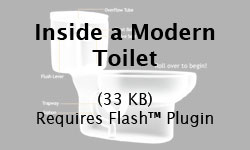Modern flush toilets have revolutionized the way humans live, yet are given minimal acknowledgment for their contributions to society. A move towards managing human waste began at least as early as the Mesopotamian civilization, and since then, toilet technology has evolved in conjunction with social and technological trends. By providing a means of maintaining sanitation in densely populated areas, present-day gravity-fed toilets have played a fundamental role in the development of urban centers around the world. The engineers who contributed to flush toilet technology harnessed the power of nature in an elegant, clever, and functional manner. Taking advantage of gravity and atmospheric pressure, flush toilets are an ingenious engineering solution to an unavoidable problem.
Introduction
Many of us have experienced the sudden nostalgia for toilets that results from uncomfortable, bathroom-in-the-bushes breaks during camping trips. Most of us have also likely engaged in epic toilet-unclogging wars, plunger in hand, fighting alongside the toilet against stubborn blockages. Yet, most of the time, the day-to-day smooth functioning of toilets goes unnoticed and unacknowledged. Despite their widespread use, flush toilets remain one of the least-recognized engineering contributions to modern society. As the founder of the Restroom Association of Singapore pointed out, people “pay homage to the toilet by making 2,000 trips to visit it a year [and yet they] refuse to talk about it” [1]. Perhaps people shy away from in-depth discussions about the flush toilet’s tremendous impact on society because of its association with sensitive, private matters. Surely the Romans’ common misfortune from before the time of toilets of being showered with the “contents of [a] urine ja” from an overhead window has faded into the forgotten past [2]. Whatever the case may be, the porcelain toilet stands faithfully at its post in private and public bathrooms around the world, a tribute to its ingenious creators who have shaped our quality of life for generations.
A Look at the History of Toilets
Regardless of the apparent simplicity of the concept of toilets, the origins of the modern flush toilet were entangled in a convoluted web of social, cultural, and technological trends. For example, urbanization in the 1800s resulted in high concentrations of human waste, giving rise to urgent concerns regarding public health and sanitation [3]. The pace of toilet development changed accordingly, accelerating during periods of European and North American “small pox, cholera, and typhoid epidemics” in the mid-nineteenth century [2]. While the engineering aspect of toilet technology is fascinating in its own right, it is imperative to acknowledge this interplay between engineering progress and social trends.
The Mesopotamian civilization pioneered the management of human waste, creating some of the earliest toilet seats (see Fig. 1 for similar toilets). These primitive structures were shaped like horseshoes and were designed to maximize comfort for the users’ buttocks. In Egypt’s Tel-el-Amarna, a toilet room dating back to 1350 BC was equipped with a toilet seat made of limestone, which featured a keyhole-shaped opening at the center (similar to the horseshoe-shaped seats of the Mesopotamian civilization). The Egyptians’ limestone toilet design did not utilize any semblance of water-flushing. Instead, the waste fell into a vessel in a hole below the seat and in turn could be used as fertilizer by the gardeners [4]. Between 3000 BC and 1100 BC, the Minoan civilization of Crete prospered and built magnificent structures like King Minos’ Palace of Knossos [2]. This remarkable palace enjoyed the luxury of a resourceful “water-supply through [tapered] terra-cotta pipes,” whose shape propelled water with a “shooting motion” and thus inhibited the accumulation of undesirable residue. The toilets at the Palace of Knossos were eerily modern for their time (c. 2000 BC), featuring a “wooden seat…as well as a reservoir for flushing water” [4]. The unique-shapely water pipes “flushed” away the waste in the toilet, closely resembling the waste-carrying water methods of modern toilets.
Contrary to common belief, Thomas Crapper did not invent the first modern flush toilet; instead, his name gained its long-lasting fame from his success as an entrepreneur in the toilet industry during the Victorian age [2]. The man historically credited with the invention of the modern flush toilet is Sir John Harington of 16th century England. Among the first to use Harington’s toilet was Queen Elizabeth (also Harington’s godmother), for whom he installed a flush toilet in one of the royal palaces. During 1596, Harington authored A New Discourse of a Stale Subject, called The Metamorphosis of Aiax, in which he described his technological creation with witty Elizabethan humor [2]. Although the book was not granted a license for printing because of its offensive subject matter, it still achieved substantial success and was published on three different occasions [2].
Understanding the Modern Flush Toilet
In contrast to the flush toilet’s roller-coaster history, the actual mechanics and physical concepts governing the way present-day toilets function are quite straightforward. Known as “gravity-fed” toilets, these flush toilets utilize gravitational force and water to wash away human waste [5]. The design of the flush toilet is an iconic example of how engineers have harnessed physical laws in an elegant, clever, and functional manner. The engineering behind Harington’s flush toilet may be divided into three principal parts: (1) bowl and siphon, (2) flushing mechanism, and (3) water tank refilling mechanism. Figure 2 takes a closer look inside a modern toilet.
A fundamental design feature of the modern flush toilet is the bowl and siphon pair. The siphon is a “bent pipe” that uses atmospheric pressure to push waste from the toilet bowl down into waste sewer system. During a toilet’s normal resting position, the air pressure above the toilet bowl water and the air pressure from the sewer pipelines form a balance. This air pressure balance, along with the arched “trapway” pipeline, results in a certain amount of water that resides at the bottom of the toilet bowl and the first curve of the trapway [2]. An engineering solution in itself, the presence of this water prevents foul-smelling odors from rising through the pipelines and diffusing into the bathroom. The siphon section of pipe works during the flushing mechanism to create a pressure difference that pulls all the water and waste from the toilet bowl to the sewer lines.
The Flushing Mechanism
The speed and quantity of water introduced into the toilet bowl are the keys to success in the flushing process. In fact, all a person needs to flush a toilet is a big bucket of water (containing at least a gallon or two) and the ability to quickly pour all the water into the toilet bowl. This is possible because the clever bowl-siphon design exploits atmospheric pressure forces and gravity. Releasing around 1.6 gallons of water into the toilet bowl at a fast rate triggers the siphoning action required for a complete flush.
The water tank behind the toilet bowl houses the quantity of water needed to generate the siphoning action. The water is stored in the tank until it is released by pressing the flushing lever. Located on the exterior of the tank, the flushing lever is attached to a chain inside the tank, which in turn is connected to the flush valve that controls the flow of water into the toilet bowl. When the flushing lever is pressed, the chain is pulled upward, opening the flush valve and permitting the water stored in the tank to rush into the toilet bowl. The potential energy of the elevated water is transferred to kinetic energy as it rushes into the toilet bowl and sweeps the waste into the trapway. A portion of the water enters the toilet bowl along the edge of the bowl, but the majority of the water flows directly to the large hole at the bottom of the toilet. This main stream of water is known as the siphon jet, because it forces the water already in the toilet into the trapway, creating a siphon.
Because of the differences in air pressure, the remaining water is sucked down into the siphon and plumbing pipelines [2]. This sucking motion of the water and waste materials continues until all the water has flown through the siphon and air enters from the toilet-bowl end of the trapway. The entrance of this air is what causes the well-known “gurgling” sound at the end of a flush [6].
Refilling the Water Tank
Once the flushing has been completed, the refilling process begins. This stage of the flushing toilet operation is vital because it makes the toilet a reusable technology. The fill valve controls the refilling process by either allowing or blocking the flow of water into the water tank. This valve has a ball float connected to it, which rises and falls depending on the water level in the tank. When the toilet is first flushed, the ball float falls as the store of water in the tank is depleted. At the end of the flush, the low position of the ball float causes the fill valve to open up, and water begins accumulating in the tank again. As the amount of water in the tank increases, the buoyant ball float is carried up by the rising surface of the water. Finally, once the ball float has reached its highest level, the fill valve shuts and no more water is permitted to enter the tank. If this shut-off mechanism malfunctions and water continues to flow into the tank, an overflow tube directs the extra water into the toilet bowl.
Latest Toilet Technology Innovations
Since the days of Sir Harington, we have seen thoughtful improvements and additions to the flush toilet design. Calls for increased sanitation have made automatically flushing toilets more commonplace. Desires to further increase convenience have fueled innovative ideas like motorized toilet seat cover systems. There have also been numerous efforts to enhance the general bathroom experience: “urinals designed for women, male urinals with built-in TV screens, automatic seat lifters, talking toilet paper dispensers, toilets that automatically weigh the user and toilets that take urine samples” [7].
Toto Ltd. of Japan released its Neorest series in 2002, a pioneering line of sleek, rimless toilets that ensures easier cleaning [8]. The Neorest 600 toilet features seat warming, sensor-triggered lid openers and flushers, “front and rear warm water washing, automatic air dryer and deodorizer,” as well as a new “Cyclone Flushing System” that minimizes refill time and noise [9]. In Germany, engineers have incorporated “integrated sensor technologies” in the design of “smart” toilets that adapt to the needs of their users. These toilets are intended to provide personalized services to populations that require special care, such as the elderly and those with disabilities [10].
Conclusion
The next time you sit down on a toilet, consider the many developments that have fed into the elegant design of today’s flush toilet. And as you watch the siphoning action suck 1.6 gallons of water down the drainage hole, recognize it as an ingenious engineering design that has enriched modern life. Using potential gravitational energy to expel waste, toilets have made modern civilization possible by allowing people to congregate in urban areas without sacrificing hygiene. Although the basic functionality has remained quite similar over the years, design features continue to be added, making bathrooms more efficient with low-flush designs and more comfortable with seat warmers and other accessories. Who knows? Perhaps one day you will be able to talk on the phone using a voice-controlled phone embedded in your toilet, probably much to the dismay of the person on the other end of the line.





